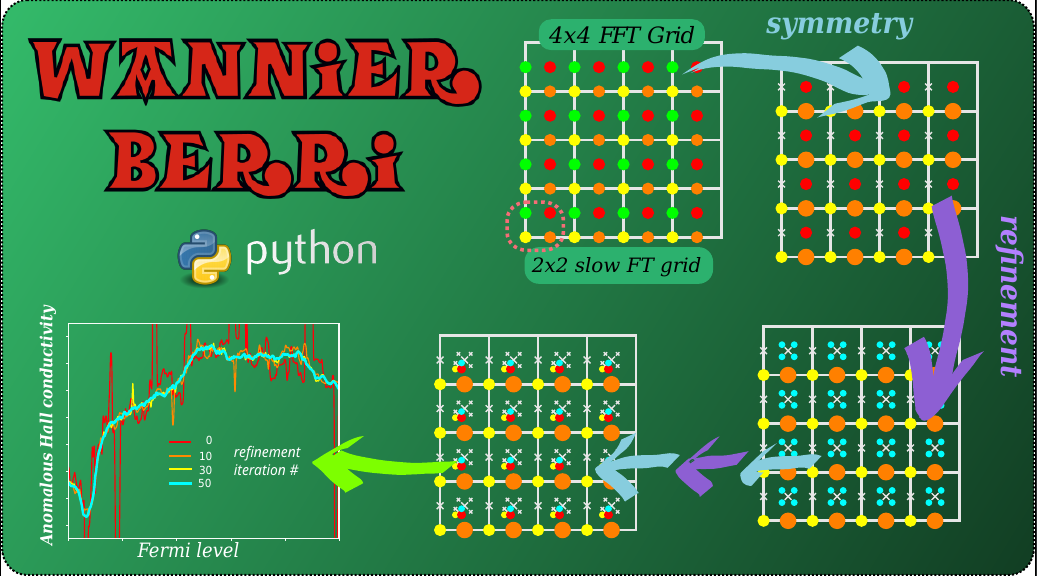WannierBerri
The Python code WannierBerri developed by Stepan Tsirkin breaks the records of speed in evaluation of anomalous transport in solids.

Stepan Tsirkin (group Titus Neupert) developed the fastest python code WannierBerri for the evaluation of anomalous transport in solids:https://wannier-berri.org/
Many properties of solids are computed via momentum (k-)space integrals, ranging from density of states to orbital magnetization and anomalous Hall effect [1]. However in order to achieve high precision of the calculations, very dense sampling of the k-space is needed, which is not achievable by direct ab initio calculation. That's where Wannier interpolation [2] gives a hand. After evaluation of bandstructure (energies and Bloch wavefunctions) over a rather coarse grid of k-points we can construct Wannier functions (WFs), which in turn do not depend on momentum, but are localized functions in real space (unlike the delocalized Bloch waves). Thus WFs may be used as a compact basis of a tight-binding model, and the Hamiltonian matrix reduces to the size of 10-100, compared to thousands and more basis functions in the ab initio calculation. This allows for a fast and precise evaluation of the band structure at any momentum without an extra call to the ab initio code. Nevertheless, unlike in tight-binding calculations, the bandstructure evaluated from WFs is precisely the same that would come out of the ab initio code directly, and it captures also fine details (Weyl points or avoided crossings) that happen between the grid points of the starting ab initio calculation. WFs are also extremely useful for evaluation of geometrical Berry phase and Berry curvature, which is an essential ingredient of the anomalous Hall conductivity and other transport properties [1].
Over the last decade the dominating code for performing Wannier interpolation was Wannier90 [3]. However, study of novel effects and novel materials put new computational challenges, which Wannier90 cannot handle anymore.
A breakthrough in the speed of Wannier interpolation was achieved in the new python code WannierBerri*, developed by Stepan Tsirkin. A boost in performance by 3 orders of magnitude is achieved by a series of new developed methods, which among others include a combination of slow and fast Fourier transforms, use of symmetries, adaptive grid refinements and schematically depicted in the figure above. The code is in continuous development, attracting more international collaborators to add more functionalities. Now the single-authored article describing the core of implemented methodology is published in npj Computational Materials [4].
It is interesting to note that the development of initial versions of the code was motivated by the challenge of explanation of the experiments of the group of prof. Johan Chang on anomalous transport in the Weyl semimetal PrAlGe [5], where excellent agreement was achieved between measurements and ab initio calculations of anomalous Hall and Nernst effects.
*The name of the code is derived from the surnames of the Swiss physicist Gregory Wannier, British physicist Michael Berry, and the Basque word "berri" which means "new".
[1] D. Xiao, M.-C. Chang, and Q. Niu, Berry phase effects on electronic properties, Rev. Mod. Phys.82, 1959 (2010).
[2] I. Souza, N. Marzari, and D. Vanderbilt, Maximally localized Wannier functions for entangled energy bands,Phys. Rev. B65, 035109 (2001).
[3] A. A. Mostofi, J. R. Yates, Y.-S. Lee, I. Souza, D. Van-derbilt, and N. Marzari, wannier90: A tool for obtaining maximally-localised Wannier functions, Computer Physics Communications178, 685 (2008).
[4] Stepan S. Tsirkin, High performance Wannier interpolation of Berry curvature and related quantities with WannierBerri code, npj Computational Materials (2021) doi 10.1038/s41524-021-00498-5
[5] Destraz, D., Das, L., Tsirkin, S.S., Xu, Y., Neupert, T., Chang, J., Schilling, A., Grushin, A.G., Kohlbrecher, J., Keller, L., Puphal, P., Pomjakushina, E., and White, J.S. Magnetism and anomalous transport in the Weyl semimetal PrAlGe: possible route to axial gauge fields. npj Quantum Materials 5, 5 (2020)
